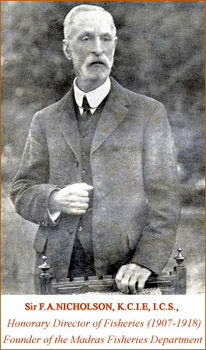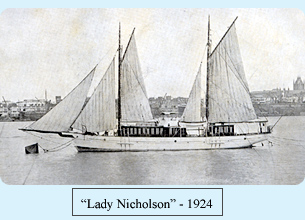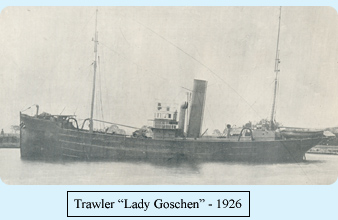-
Call Us On:
044-29510390 -
Send us a Mail:
tnfisheries@nic.in - தமிழ் Buy Fish
During 19th century, the fisheries was the only source of sustenance for a segment of the population living in the coastal region, and on the banks of rivers, lakes and canals in India.
Fishing in general was a hereditary profession carried on from generation to generation with almost all the members of the family taking part in it to varying degree. The socio-economic condition of fishermen was very poor. The fishermen belonged to the lowest stratum of society and fishing was generally regarded as one of the meanest of all trades and profession.
The earlier contributions to fisheries in India were the study of the Indian fish fauna by James Russel (1785-89), Dr. Buchanan Hamiltons catalogue of the fishes of the Ganges published in 1822, Co.Alcocks findings of marine fisheries in India published in 1869, starting of the Indian Marine Survey Station in 1875 and the launching of the survey ship Investigator.
The Government of India (GOI) deputed Dr.Francis Day to investigate the fresh water resources of South India and then for the whole of India and Burma. Dr.Day of Madras Medical Service who worked as Surgeon Major with the British troops in Bengal and who functioned as the Director General of Fisheries of India in 1864 published two reports in 1878; the Freshwater Fish and Fisheries of India & Burma and Sea Fish and Fisheries of India. Dr.Day in his Pioneering effort brought legislative measures to conserve the fisheries. On that basis the Indian Fisheries Act (Act IV of 1897) was passed for the whole of India, by which dynamiting and poisoning of waters for killing fish were absolutely prohibited. This Act empowered the erstwhile Provincial Governments to frame rules for regulating (a) the erection and use of fixed engines, (b) the construction of weirs, and (c) the dimension and kind of nets to be used and the mode of using them; and for prohibiting all fishing in specified water for a period not exceeding two years. The enactment of this Act was an important event that took place in the history of Fisheries of India. Days endeavours also resulted in the grant of duty free salt for curing fish.

1.The Government accept generally Sir F.Nicholson's proposals as to the formation of a fishery bureau. They consider that the appointments he suggests are suitable and may be permanently created with effect from 1st April 1907, the pay of the assistant being fixed at Rs.175-5-200 per mensem. The Government of India will accordingly be moved to sanction the creation from that date of the following appointments:
As the direction of the lines and the methods of investigation will continue to rest with Sir.F.Nicholson during the two years of his prospective direction of fishery work, the Government consider that he should be styled "Honorary Director" instead of "Honorary Adviser."

During 1905, Sir Frederick Nicholson was appointed in a temporary Fisheries Officers post and was deputed for a period of two years to investigate the fishery industry in the Madras Presidency and submitted. After the tour he sent proposals to Government for the initiation of a small Bureau of Fisheries for Madras with the aim of increasing fish production, promotion of fish based industries and improvement of socio-economic conditions of fishermen. By establishing a Bureau of Fisheries in 1907, the Madras Presidency became the pioneer in India. Sir Nicholson was appointed as the Honorary Director of the Bureau of Fisheries in 1908. Two European experts, Mr.Wilson Hentry.C as a pisciculturist and Mr.James Homell as a marine biologist were appointed to assist him. Earnest efforts were taken by the above three officers and their successors for the development in all fields of fisheries and the Madras Fisheries Department became the forerunner in the development of fisheries in the country.
Mr.James Hornell succeeded him in 1918 as the first full time technical Director of Fisheries. Initially fish preservation methods such as fish curing yards were started by the Department during 01-04-1924.

In 1907 two cruises in search of trawling grounds were undertaken by Messrs.Hornell and Cribb when in the employ of the Ceylon Pearl Fishery Company with the companys trawler Violet, in the course of which an extensive trawling ground of five thousand square miles (Wadge Bank) off Kanyakumari and other smaller banks adjoining Tanjavoor Coast were discovered. Apart from this, survey with trawls along Malabar coast with SS Margarita in 1908, fishing off Cannanore and off Tuticorin with Sutherland and Turbinella during 1908-11, fishing experiments by with Sea Scout during 1922-24 and exploratory fishing with vessels Lady Nicholson, T.R.8, Lady Goschen, Sea Scout and Leverett during 1927-30 were the earlier activities. Eight motor fishing vessels were used for shark fishing and as mother vessel for towing canoes and catamarants to the fishing ground in 1946. Experimental fishing with hand lines on the Wadge Bank and for flying fish off Nagapattinam was conducted in 1949. During 1945, a special unit under Mr.E.K.Madhavan was organized in the department for designing and building small-motorised boats. After the successful operation of the first motorized boat Ajit in Adiramapattinam in 1948, eleven more boats were built. Fishing demonstrations using long lines, surface gill netting and boat seines were made at specific centres.
Mr.Hornell was the first to propose mariculture system in India and identified Krusadai Island for setting up mariculture farms. The cultivation of the edible oyster was first contemplated in 1907 and research work was carried out. He undertood survey of Pulicat Lake in 1908. In 1910, some cultural methods were started at Pulicat. From 1921 onwards oysters were regularly marketed after hygienic treatment though on a small scale. About 1910-11, Mr.Hornell started supplying biological specimens to various institutions and persons. A handbook entitled The Common Molluscs of South India was published by Mr.Hornell by 1920. In 1924-25 identification of marine biological specimens and formation of a reference collection at Ennore was started. Marine fisheries research in an organized scale in India was first carried out in the Madras Presidency with the establishment of Marine Biological Stations at Krusadi (1924), West Hill and Ennore. The Madras Marine Aquarium was opened in 1909 as an adjunct of the Museum. It was brought under the control of the Fisheries Department in 1919 only. The Fisheries Department immediately made the aquarium more attractive to the general public by increasing the number and variety of exhibits.

Pearl and chank fisheries were crown monopolies enjoyed by the local rulers of the region from time immemorial.
After independence the GOI got the assignment of FAO Expert Dr.R.Baschieri Salvadori of the Giardino Zoologica (Zoological Garden) of Rome for the period from November 1958 to May 1959 to carry out under water exploration of the pearl and chank beds in the Gulf of Mannar to assess accurately the conditions and population of the sea shell fisheries.
The pearl fishery occurred in irregular cycle. Mr. James Hornell who was called the father of pearl and chank fisheries of India and Ceylon. Thirty-nine pearl fisheries had taken place during the period 1663-1961. The last pearl fishery was during 1956-61 and nearly 760 million pearl oyster pinctada fucata were harvested from the pearl banks of Tuticorin.
Mr.Hornell sowed the idea of pearl culture in 1916. The pearl fishery could not be conducted after 1961 due to paucity of oysters in the natural bed. The success in production of spherical pearls was achieved by CMFRI only in 1973. the CMFRI developed a research centre for pearl culture at Tuticorin and also collaborated with the Department of Fisheries, Tamilnadu during 1973-78. The technology was scaled up for large-scale production. The TNFDC took up pearl culture on Commercial scale on joint venture. At present the pearl culture project and pearl oyster hatchery at Mandapam have been leased to a private party.
The Tuticorin chank fishery was taken over by the State Fisheries Department from the Port Officer, Tuticorin on 01-04-1909. The chank fishery was an annual feature. Chank fishery (Xancus pyrum) was commercially important in Tamilnadu, contributing to landing of 8 to 10 lakhs a year and offering employment to about 1,000 divers during the chank fishing season (October-May in the Gulf of Mannar and from June-August in the Palk Bay, when the weather was favourable and waters were clear). The Tirunelveli (usually called the Tuticorin) chank fishery was operated departmentally under the direct departmental supervision. The divers who participated in the fishery had to take out a license for diving and surrender their collection of chanks at a price fixed by the Government. The Ramanathapuram chank fishery and the Coromandel Coast (Chingleput, South Arcot and Thanjavoor) chank fishery were leased out for a term of three or more years. At present the demand for chank has declined and there is neither departmental fishing not leasing and the chank fishing in the whole state is permitted by issue of licenses.
During World War II, agar was needed for medical and public health work and also the banning of imports from Japan gave the impetus to look into our seaweed resources. In 1940, agar was for the first time processed in India simultaneously at the laboratory of the Scientific and Industrial Research Board, Delhi and by the Department of Reasearch of Travancore.
The initial development in fisheries was planting high altitude streams with trout for recreational fishing by the British. The attempts by Dr.Day in 1863 and 1886 and Mr.M.Ivor in 1867 to import and stock trout in Nilgiris had failed. In 1906 Mr.Wilson obtained 100 fingerlings from Ceylon of which only 27 survived and were released in Parsons Valley stream. In 1907 be obtained ova from New Zealand and successfully hatched them. This rainbow trout (Salmo gairdneri) established well in the Nilgiris district. Tench of Doctor fish (Tincatinca) and English carp (Carassiuscarassius) were introduced from Europe into Ootacamund in 1874. Mr.Wilson introduced Gourami (Osphronemusgoramy) from Mauritius and Java into India 1916. 44 fingerlings of Mirror Carp (European Carp Cyprinuscarpio) imported from Ceylon were stocked in the Crescent pond in the Ooty Botanical Gardens in 1939. By 1943, they had bred and figerlings were available for further stocking. Tilapia mosambica was introduced into Madras Presidency in 1952. The other fishes introduced were common carp (Bangkok strain) in 1957, silver carp from Hongkong to Cuttack in 1959 and grass carp from Japan to Cuttack in 1959 and 1969.

Mr.Wilson was called the founding father of inland fisheries development in the south. In memory of him, the fish farm at Ooty was named as Wilson fish farm. The credit of establishing trout culture in the Nilgiris on a firm and scientific basis goes to Mr.Wilson. a trout hatchery at Avalanche in Nilgiris district was constructed in 1907. In 1909 a hilsa hatchery was established a Lower Anicut on the Coleroon River. Mr.Wilson succeeded in artificially fertilizing Hilsailisha eggs but the hatching was not successful. Dr.Sundara Raj took charge of the experiments in 1915.
Mr.Wilson took special initiative in breeding and supplying of larvicidal fishes for mosquito control. Ippur fish farm in Nellore district was established in 1917 mainly to breed larvicides in large numbers and distribute throughout the Presidency. In order to have extensive experiments, a fish farm at Praema near Nandyal was established in 1927.
Tamilnadu is pioneer in reservoir fisheries development. Even before the completion of the construction of the Stanley Reservoir (Mettur Dam) in 1934 pre-impoundment stocking of Catla was carried out. The cardinal principles of pre-impoundment survey, stocking, conservation and management were adopted. Every reservoir had a fish seed farm attached to it. Research work on the water quality and the productivity of the reservoirs was carried out. The evolution of Rangoon nets (vertical walled surface gill nets of different mesh size) had also its beginning in Mettur and found its way into other reservoirs.
Mr. K.H.Alikunhi initiated research work on inland fisheries under the ICAR sponsored Madras Rural Pisciculture Scheme in 1942 and hundreds of rural fishery demonstration ponds sprung up all over Madras Presidency. This was the first extension project translating the research findings into production programme and was the forerunner of the very successful Fish Farmers Development Agency (FFDA) scheme initiated in 1973-74 by GOI. In the mid forties, Madras Fisheries had the distinction of starting a hydrobiological station in Chetpet, Madras.
Fish curing was an age-old industry in India, but the methods in use were generally primitive and susceptible of great improvement in regard to the flavour, appearance, cleanliness and keeping quality of the product. Fish curing yards were set up in 1874 by the Board of Revenue to provide wholesome salted fish to the public and to curb the use of salt earth by the curers. Duty free salt was supplied for curing fish within enclosures. In 1908, an experimental station was opened by the Fisheries Department at Ennorenear Chennai for conducting experiments in salting, curing and preservation of fish.
To introduce the improvements in regard to cleanliness and sanitation, proper salting and drying, six Government fish curing yards were transferred temporarily from the Salt Department to Fisheries in 1917.
In Madras Presidency, the livers were brought by the fishermen to the nearest fish curing yards, where they were cleaned, washed and boiled in open tin-coated copper pans with water. The fishermen were paid from 12 to 37 paise per lb (13 to 39 nayapaise per Kg). Sixty fish curing yards on the east and west coasts had been provided with equipment for extraction of the oil and the yard officers had been given the necessary training in oil extraction.
An experimental holothurian curing facory was opened in 1915-16 at Tirupalaikudi in Ramanathapuram district and was continued till 1927-28. Departmental efforts in this line gave an impetus to the local merchants who undertook the curing on the same line as was conducted by the department.
Some initial experiments in refrigeration conducted by the department in 1912-13 with ice and subsequently with a small ammonia brine-freezing plant, according to the Henderson method in 1915-16 at the Chaliyam Cannery, proved that the method could be adopted with success technically. In 1918-19, a pair of twin refrigerating tanks were constructed at Tanur, to experiment in sharp freezing and in chilling of cheap fish e.g.Sardines.
The beginning of the cooperative movement in India can be traced to the enactment of the Credit Cooperative Societies Act, 1904. The first fishermen cooperative society was organized at Malpe in South Kanara in 1913. It was considered that cooperative could be a powerful tool for the upliftment of fishermen communities. In 1918, Madras Government laid down that the development of the fishing community was the primary duty of the department and directed that the spread of cooperative methods among fisherfolk be accelerated. In recognition of the fact that the fishery officers were in the best position to supervise the cooperative work among fishermen, the officers of the Fisheries Department were invested with powers to organize the fishermen cooperative societies and to inspect the books of societies for which the Cooperative Societies Act and Rules were amended suitably. The number of fishermen cooperative societies increased from the level of 9 in 1918 rose to 195 in 1957.

The rate of illiteracy among fishermen was significantly very high and hence earnest efforts were taken to reduce this rate. In 1913, a special Fisheries School was started by the Fisheries Department at Tanur in the West Coast. By 1919, Government sanctioned the opening of a training institute at Calicut for the training of schoolmasters of fisheries schools and they were given special technical instruction in Fisheries. There were 30 day schools and 4 night schools for educating the fisher children freely in 1929. By 1950, there were 49 elementary and 10 higher elementary schoolswith a strength of 19,510 pupil. After the reorganization of states in 1956, there were only 3 elementary schools in Cauvery poompattinam, Sathankuppam and Alambarikuppam in Madras State.
The Director of Fisheries initiated measures for development of the pearl fishery, manufacturer of fish meal, canning of fish and fish curing yards. Thrust for experiments and research on all aspects of Fisheries was also the concern of the Director of Fisheries.
This facilitated the Department to initiate broad based socio economic development of the fishermen, collection of statistics, record of observation of fish and fishery, introduction of improved methods of capture fishery, marketing fish and fishery products. The fish curing yards (which were earlier under the control of Salt Department) also enabled the Department of Fisheries to establish contact with the coastal village as well as marine fishermen.
In sixties, the Department, this was part of the Industries and Commerce Department till then was declared as an independent department in 1965. In 1967, the Department was organized on Regional basis with the sanction of four posts of Deputy Directors of Fisheries at Chennai, Madurai, Coimbatore and Tuticorin. One more region was formed at Nagapattinam in 1976. During April 2000, the Department was reorganized on functional lines separate Assistant Directors were assigned for each of the broad based functions like Marine, Inland, Aquaculture, Research, Extension and Training, Exploratory Fisheries, Fishing Harbour Management with their jobs and responsibilities well defined. Their geographical jurisdictions were also rationalized to ensure better performance.